Connemara after the Famine
Published in 18th-19th Century Social Perspectives, 18th–19th - Century History, Features, Issue 2 (Summer 1996), The Famine, Volume 4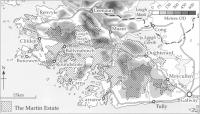 In August of 1849, in London, a huge property was put up for auction: the former Martin Estate in Connemara. According to the prospectus:
In August of 1849, in London, a huge property was put up for auction: the former Martin Estate in Connemara. According to the prospectus:
It is impossible for the mind of man to conceive anything necessary but capital, and a judicious application of it, for rendering this vast Property fertile beyond a parallel, that this Estate does not contain within itself; facilities for Draining, the formation of Roads, inland Navigation, abundance of lime, sea-weed for manure, valuable kelp shores, innumerable beautiful sites for Buildings, and the soil generally might be designated, to use a homely phrase, as one vast dung-heap.
The estate, of 196,540 acres, comprised most of the land west of the town of Galway to the Atlantic. The rent roll was to be read in the light of the following special inducement to buy:
The number of Tenants on each Townland, and the amounts of their Rents, have been taken from a Survey, and ascertained Rental in the year 1847, but many changes advantageous to a Purchaser have since taken place, and the same Tenants by name, and in number, will not now be found on the Land.
As that year of 1847 had been the worst of several consecutive years of famine, it was to be understood that those missing tenants had abandoned their holdings to crowd into the workhouses or the emigrant ships to the New World, or they were dead; in any case they no longer infested the ground, which was left as a blank canvas on which Capital could paint a fair and profitable landscape.
Obscure hinterlands
Topographically Connemara appears as a natural refuge, or as a trap. Lough Corrib fences it off on the east, and the Atlantic provides the rest of its bounds: a low and labyrinthine shoreline along the south, westward-thrusting reefs and promontories, and across the north, a sea-inlet almost comparable with a Norwegian fjord, Killary Harbour. Steep mountains occupy most of the northern half, much of the south is a sea-level plain intricately interrupted by some two hundred lakes, and both highlands and lowlands are blanketed with bog, fed by a copiously oceanic sky. In early historic times (but history only made brief and tentative incursions here until much later) most of this territory was held by the Conmaicne Mara, the Conmaicne of the Sea; the name ‘Connemara’ is almost the only trace of their former presence. In the early thirteenth century they were eclipsed by the O’Flahertys, who had been masters of the fertile plain stretching eastwards from Lough Corrib, until they were driven into the wilds beyond the lough by the Normans.
Thereafter, for three hundred years, the O’Flahertys ruled and feuded in their obscure hinterlands according to the old Gaelic ways, while Galway grew into a little walled town, sea-linked to Renaissance ways, controlled by an oligarchy of merchant and banking families of Norman origin, among whom the Martins were prominent. The disaffected and rebellious O’Flahertys were the natural enemies of the Galway merchants, but the rending of Europe between two faiths eventually brought them into alliance in the 1640s. Both supported the Catholic Confederation; both suffered for it when England’s parliament overthrew the king, and Cromwell’s army savaged Ireland. The O’Flahertys were expropriated, and their rugged patrimony distributed to Cromwell’s financial backers and to Catholic landowners dispossessed of better lands now reserved for Protestants. The Martins lost some Galway property, were given large tracts of western wilderness in compensation, and bought out the Cromwellian adventurer who had acquired Ballynahinch in the heart of Connemara. Not for nothing was the head of the Martin family a lawyer known as Nimble Dick; by adroit dealing the Martins bobbed to the surface, after fifty years of religious strife, as the largest landowners in either Britain or Ireland.
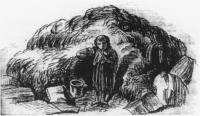 Humanity Dick
Humanity Dick
Nimble Dick’s grandson Richard Martin became Member for Galway at Westminster, and a friend of the Prince Regent. Nicknamed ‘Humanity Dick’ for his legislation on animal welfare, and ‘Hair-trigger Dick’ for his notorious duels, Richard Martin was in all senses an extravagant figure in London society, and Ballynahinch, where his father had built a modest mansion, was his necessary refuge from controversy and duels. It seems that the Martins were less oppressive than several neighbouring landlords, and folklore remembers them more kindly; Richard Martin’s relationship to his tenantry was more that of a patriarch than of an evicting and rackrenting absentee. The outside world, lifting its eyes from the pages of Sir Walter Scott, found the idea of the Martin kingdom immensely appealing, with its high-spirited defiance of civil law, the devotion of its wild clansmen to their master, its fabled hospitality floated on a sea of smuggled brandy, and its backdrop of trackless wastes and stormy skies. Charles Lever used Ballynahinch as the setting of a novel, and Maria Edgeworth and Thackeray were among those who visited Richard’s son Thomas Martin in the days when he was called the King of Connemara and his daughter Mary its Princess.
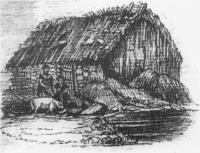
”Catherine O’Donnell’s Hostlry
Death’s-head landscape
This veil of romance was torn away by the Great Famine, revealing a death’s-head landscape. Reports from Connemara were as terrible as those from anywhere in Ireland. The Martins, bankrupted by generations of high living and the general collapse of agricultural profits that followed the end of the Napoleonic Wars, could do no more for their starving people than did the worst of the evicting landlords. Thomas went to visit his former tenants in the workhouse, caught the famine fever, and died. The mortgagees, the Law Life Insurance Society of London, soon had the estate put up for sale, with the vulturish commendations quoted above, and when there were virtually no bidders, bought it in very cheaply. To make it a saleable property they set about clearing the land by evictions, and, being as well versed in Walter Scott as anyone else, added battlements to the Martins’ plain house. However it was not until 1872 that a London brewer, Richard Berridge, took the bulk of Connemara, plus a few small Mayo estates, off their hands for £230,000.
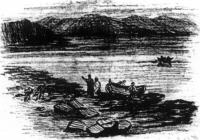
‘Dooeyher Bay’
A potato-fed, rent-producing stock
I have summarised this history in terms of a few prominent names; but who were these historically anonymous folk who, in the eyes of their betters, were a mere natural feature of the countryside, to be cleared like scrub when they didn’t benefit the land? The O’Flahertys were still numerous in Connemara, and the O’Malleys who looked back to a comparable glory in west Mayo. The O’Hallorans and O’Duans had been stewards to the O’Flahertys, and the O’Lees their hereditary doctors. The Joyces were originally Norman-Welsh and had settled in the north-east of the area under the protection of the O’Flahertys. But all these were long reduced to small tenants and, at the best, small middlemen. They were Catholic, visited holy wells, revered saints no one outside of Connemara would have heard of. They sang, prayed, mourned and cursed in Irish, and they had their famous storytellers and poets. They lived in clusters of one- or two-roomed cabins, under thatch; they farmed on the rundale system, each household having a scattering of little stone-walled plots and pastures on the improved land near the village, and grazing rights on the bog and mountainside. They fished from canoes or small sailboats, cut turf and ferried it to the Aran Islands and Galway city, and gathered seaweed for kelp-burning. Since their work called for many hands, and extra plots to feed them could always be won from the margins of the limitless bogs, early marriage and lots of children were advantageous, and the population, concentrated in a narrow coastal strip, grew astoundingly, until it was a puzzle to visitors what they could all be living on. From the landlords’ point of view these folk were primarily a potato-fed, rent-producing stock; and when the potato failed, as it did periodically because of drought or excessive wet or disease, the ragged ridiculous creatures could slave for yellow meal on relief work schemes, or emigrate, or starve.
Hand to mouth existence
Whereas their neighbour landlords the D’Arcys had developed a town and a port on their land at Clifden, most of the Martins’ rent-roll was wasted in profligate living abroad or ill-advised mining ventures at home, and their estate was largely unimproved. The only settlement on it that was more than an agglomeration of cabins was at Roundstone, where the engineer Alexander Nimmo had built a harbour in 1822 and laid out a neat village, which had flourished for a few years with the herring fishery and then had fallen into decline. In general Connemara lived from hand to mouth, unable to lay anything by against bad times. Thus when the potato crops were blighted again and again from 1845, the folk could only plead for a job breaking stones, and when the relief works were shut down, sell everything to buy food, and then abandon their holdings to face the horrors of the Atlantic crossing or the fever-ridden workhouse. Connemara’s agony was of course shared by most of Ireland. The shameful record of the Whigs under Lord John Russell, after the fall of Peel in 1846, cannot be expunged by historical revision; here was a ruling class of immense wealth and power letting its humanity be overruled by the idea that laws of economics were laws of Nature and therefore laws of God—always an attractive belief to those in whose favour the so-called laws are working. In 1847 the new government transferred the cost of famine relief onto the poor law rates. The result in Connemara was typical: since the rate-paying property-owners were being bankrupted by the loss of rents, the workhouse had to close, and its desperate inmates were sent out into an utterly destitute world. By the time of the abortive sale of the Martin estate in 1849, hunger and disease had seen to it that, indeed, ‘the same Tenants by name, and in number’, would not be ‘found on the Lands’.
Thomas Colville Scott arrives
London Thursday, Feby 3rd 1853: Left London this afternoon, by the 5 p.m. Express Train, for the County of Galway, Ireland, to execute my first important Commission, namely, to survey, value, and report on, the ‘Martin Estate’, Connemara, for a group of gentlemen represented by Mr. ‘Coverdale, Solicitor, Bedford Row’, and who propose to purchase the entire Estate, containing nearly 200,000 acres, from the ‘Law Life Insurance Company’.
One senses the energetic, factual, commercial temper of Victorian England working like pistons in that 5pm express train out of London. But the efficiency of the railway system, recently extended to Galway, only delivers the young surveyor all the more promptly into a land stunned by misfortune. Five weeks later, when, back by his own fireside in ‘the great metropolis’, Colville Scott tries to arrive at general conclusions, his mood is very different:
If, now, I take a retrospective glance at the scenes and the people I have just left, how puzzling the theme, how vague the thoughts, how indefinite the resolution!
And although he goes on to assure himself that the ‘state of Ireland’ cannot just be a mystery, that it must arise from known historical circumstances, his attempts to explain the horrors he has seen fall back on the colonialist commonplaces of his times: the benightedness of Roman Catholicism and Paddy’s fecklessness. Much more valuable are his unsentimental and spontaneous descriptions of the people he met as he probed into every corner of the wreckage of the Martin estate, individuals who, whether traumatised to the point of imbecility, or bettering themselves on almost invisible means, are at least spared the final ignominy of burial in statistics.
Evangelical exploitation
Among the misfortunes visited upon Connemara at that time was an attempt to make it ‘come out from Rome’, headed by an English clergyman, Alexander Dallas, who was convinced that the Famine had been sent by God to further that end. Colville Scott was of course a church-going Protestant, and attended morning service at Roundstone on the day after his arrival at Ballynahinch. The subject of the sermon was Transubstantiation, and it was not, he felt, handled ‘in a way likely to enlighten the understanding or improve the feelings [of] the congregation consisting of those patted children who are so ardently pounced upon in the west as the fittest subjects for proselytism’. He found that there was almost open war between the Catholic priests and the Protestant evangelicals, and noted that ‘this work of conversion is done with rather too much chuckling triumph over the Roman Catholics to obtain the support of others than the interested casuists’. Indeed the evangelical exploitation of misery in post-Famine Connemara, the contamination of charity by the use of food as a religious persuasion, was a shocking episode, and one is relieved to see that young Colville Scott, an average sensible Briton, is repelled by it.
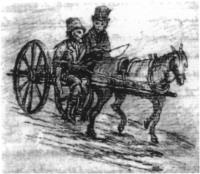
Mr Hitchens in pursuit of nuggets
No Irish animation
As if in grim mockery of the theme of Transubstantiation, it is in returning from this sermon on theological niceties, that he first comes across ‘the rude graves in the Bogs, Quarry holes and even on the ditches, into which the unfortunate people were flung in the time of the famine of ‘47’, when, he learns:
The very dogs which had lost their masters or were driven from their homes became roving denizens of this district and lived on the unburied or partially buried corpses of their late owners & others, and there was no help for it, as all were prostrate alike, the territory so extensive, and the people so secluded and unknown.
On the following days, with three inches of snow on the ground, he explores a remote part of the
estate from which hundreds of poor tenants had been driven off ‘by a combination of Soldiers, Revenue
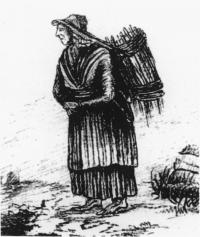
The Peat- Gatherer
Officers, and the Constabulary’. There were still hordes of squatters and ‘unrecognised subtenants who pay to the middleman double his entire rent’.
I saw these subtenants at work, most of them widows, forsaken wives, and young women, carrying peat on their backs. They were nearly in a state of nudity, and appeared, from actual want, to be reduced to a state of Idiocy. There is no Irish animation here, but a stealthy and timid look, as if the poor souls were ashamed of their condition, and lost to the faintest hope of escape from wretchedness and misery. Good God! where are their Landlord[s] & the responsible power that rules over them: have they never looked into these all but vacant faces only animated with a faint imploring look—have they never seen the bent back of the aged, and the sunk cheek of the young? Then let them come here and see what neglect has done.
Industry from wrong motives
But at the end of that bitter day he is cheered to encounter a young woman renting a forty-acre farm, managing a dozen or so men and women, paying them no wages but cooking well for them, and selling her eggs, butter and corn in Clifden market. Such contrasts recur as he quarters the estate, and he has the greatest difficulty in evaluating some of the modes of survival he comes across. At Glinsk on the Carna peninsula, among hundreds of forsaken cabins, the collapsed thatches of which did not hide the whitened bones of those who had died in them, he sees
a ‘Water Corn Mill’ of about half a horse power. Thought this effort at least commendable, and complimented the Owner, but the subagent, who accompanied us, smiled at my credulity and said that it was simply an excuse to dry and grind malt during the night, for illicit distillation, and that he would have it pulled down! Alas! Alas! It appears that the only attempts which Paddy makes at what seems, to a stranger, to be settled industry, are done from wrong motives.
However, he is almost moved to condone this industry by the plight of the inhabitant of a cottage in which he stables his horse one day while exploring remote recesses of the Maam Valley:
a miserably poor woman who used to live by selling ‘Potheen’—or illicit whisky—but her trade had been ruined by the Gauger [excise officer], and herself also. Her hut was only ten feet square, and she herself appeared to be in a state of bewildering poverty and starvation. She said she sometimes still got a drop at times to sell, and the excise officers would occasionally pass her house although aware of its possession, because they knew that she must lie down and die if not allowed to sell a ‘leetle’ now and then… Her mind seemed wandering and approaching delirium from want. These are awful sights to see unmistakably existing in a wealthy Country, but who could ever search out poverty or even human beings, in these wild and secluded spots? Yet few would be thus neglected if the Owners of the Irish soil, and the Priests of the people, were fully awake to their great responsibilities…
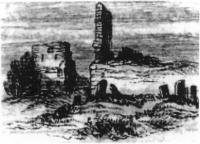
Burying-ground and ruin near Oughterard
‘No fair field for Paddy’
In his anguished pursuit of someone or something to blame, Colville Scott comes close to saying that Connemara could support its people, but not the superimposed social orders to whom he is reporting. For while there was land here and there of productive potential, these cultivable plots were too small to be ploughed and too scattered to be united into farms big enough to provide more than mere subsistence; in fact the only people who could live off this terrain were the spade-wielding smallholders who had created those patches of tilth. (In this conclusion Colville Scott is in agreement with recent ideas in historical geography: the rundale system was not an obsolete antiquity preserved in the far west by isolation, but a sound adaptation to the human habitat; only the constant drain of resources through rent, and the imposed dependence on the potato, made the society based on it so vulnerable.) However, mere sustainable subsistence is not what life is about, in Colville Scott’s eyes. Throughout the region he finds that:
Every spot of [soil], however limited in extent, barren in productive powers, or inaccessible in situation, is turned up, and, in many cases, beautifully tilled. I always feel a sorrowful regret to see so much mistaken industry,—the crops do not half repay it; no English labourer would undertake a tithe of the toil for the whole reward; and in fact it looks like a blindfolded war with nature, in which Paddy does himself great injustice, there being no fair field for him.
A fair field would be one that lets ‘Paddy’ produce a surplus for the landlord, of course, and there would still remain the problem of surplus humanity not requisite to this end. Although Colville Scott is troubled by the inhumane execution of clearances, he does think that giving the poor a bit of money to go elsewhere is a sensible procedure. Thus when on a neighbouring estate at Moycullen he comes across a wretched widow and her boy sitting in the snow that falls into their roofless cabin, he is moved to give her a shilling and inquire into her situation; but on learning that the landowner, Lord Campbell, is allowing ejected tenants all arrears of rent and ten shillings more when the roof is pulled off their cabin, he comments that ‘This proceeding, though apparently a harsh one, is wise and necessary to prevent a recurrence among these unguided people, of pestilence, famine, and untimely death.’ The fact that the cabin was their home does not obtrude.
Naked chimney sweep
We do not have Colville Scott’s final report to his London clients, but it was no doubt negative. Instead his journal ends with an armchair essay on ‘the Irish problem’, in which ideology overwhelms what common sense he had picked up in Connemara. So the value of his testimony lies in the human images he transmits to us, as it were before he has had time to muffle the shock of personal encounter in social theorising. One of these, both starkly elemental and richly individuated, is likely to haunt the reader’s mind as the very personification of that inhabited desolation, Connemara after the Famine:
In the morning we met an Irish curiosity, namely a Chimney sweep boy about ten years old, and three feet high; he had run away from his employer in the town of Galway, and had reached this out-of-the-way spot, 60 miles distant, without a stitch of clothing, except a belt of sacking, about one foot in width, around his waist! When we met him, a thick shower of snow was falling, and he was running along with his hands over his shoulders and a little hoe under his arm. I stopped him and asked his history. He laughed and told me—adding that he had just swept the Priest’s chimney, and was on his way to do the same good office at the Constabulary Barracks. I asked where he put his money when he got it, and he said, in his hand, ‘but’ said I, ‘how will you do when it accumulates?’ ‘Oh’, he replied, ‘I’ll fall upon a plan when that occurs.’
Surely this apparition is William Blake’s chimney-sweep, mysteriously transported from London:
Iittle black thing among the snow,
Crying ‘weep, weep’ in notes of woe!
except that, in Connemara, he is laughing. Colville Scott sensibly arranges to have him scrubbed and provided with a coat; and, in his journal, brings home to us that appalling laughter.
Tim Robinson is a writer living in Roundstone, Connemara.
Further reading:
T. Colville Scott, Connemara after the Famine: Journal of a Survey of the Martin Estate, 1853, edited with introduction by Tim Robinson (Dublin 1995).
















